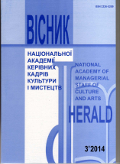ВЕСІЛЬНИЙ ОБРЯД УГОРЦІВ ЗАКАРПАТТЯ КРІЗЬ ПРИЗМУ СУСПІЛЬНО-ПОЛІТИЧНИХ ПЕРЕТВОРЕНЬ: друга половина XX ст.
Wedding ritual of the Hungarians of Transcarpathia in the light of social and political changes in the second half of the 20th century
Author(s): Viktoriya OliynykSubject(s): Anthropology, Cultural history, Ethics / Practical Philosophy
Published by: Національна академія керівних кадрів культури і мистецтв
Keywords: the Hungarians of Transcarpathia; wedding ritual; traditional culture; family; marriage;
Summary/Abstract: One of the oldest Hungarian centers in Ukraine that was and has remained Transcarpathian region, where according to official figures, the number of the Hungarians is about 151, 5 thousand people, has been studied in this article. Based on the materials of the famous scientists and their ethnographic study, the author considers the Magyars wedding ritual of this region as an integral part of Hungarian traditional culture of the area. The relevance of this topic is to study the problem of historical reconstruction of the wedding ritualism of the Hungarians in the multicultural conditions of the region. Active increasing of social attention to high- quality level reproduction of the historical foundation of the traditional culture of the Hungarian national minorities, leads us to formulate and further to solve important issues of stylistic adaptation of folk traditions to requirements of modern Europeanized wedding culture of Ukraine. In order to define the main direction of this study, it is necessary to pay special attention to impact of major social and cultural tendencies in historical formation of mentality and traditions of the Hungarian population in Transcarpathia.The works by L.Kovach, M.Horvath, P.Shandor, O.Balla are used in this article on issues of history of Hungarian traditional culture; material culture of Transcarpathian population – I.Symonenko, S.Makovskyi, archetypical modules in family relationships of the population of Soviet Ukraine – A. Ponomaryov; fundamental study of ethnography of Transcarpathia – M.Tyvodar; materials of ethnographical society under the chairmanship of A.Voloshyn (archival materials of the town Mukachevo, Transcarpathian region, the middle of the 20th century); ethno-mental components of the wedding ritual of the Hungarians are the main studies of the author of this article. The aim of this study is the identification of the determination level of the Hungarian wedding ritualism under conditions of polyculture in Transcarpathia. It should be noticed that people’s idea of world conception is, in fact, its philosophy, to tell the truth, naive, with powerful mythological layer. In order to understand the essence of folk world conception, it is necessary to remember the fact that the Hungarians of Transcarpathia are farmers, whose principal basis in the formation of cultural traditions and customs is the cult of fertility, vegetation. It was Transcarpathia, where customs and ceremonies of ancestors were kept and passed by in folk culture and great attention was paid to their expansion despite powerful prohibition, in the second half of the 20th century. Different norms of behaviour, rituals, beliefs and superstitions were connected with them which created special atmosphere of solemnity, secrecy of these traditions, with a kind of semantic layer and connection of levels of different time ideas of world conceptions, beliefs and knowledge. Gradual historical development brought changes in all spheres of social life, including family. Ethnographic materials testify great attention in folk environment to inside family relationship and their dependency, first of all, on spouse relationship of a husband and a wife. It is worth emphasizing that, family institution underwent exceptionally great and essential changes in Transcarpathia in the second half of the 20th century, with radical political and social and economic reforms, cardinal ideological and moral and ethical reorientation, decades of totalitarianism, repressions, hard times after the war, large- scale migrations and forced deportation and forced labor migration abroad which is still considered to be unprecedented state intervention in the family sphere. Due to massive outflow of population from the countryside, the rapid process of urbanization in Transcarpathia, the number of urban families highly increased and the number of rural families dramatically reduced. Since 1960s the tendency of aging of villagers has become really threatening, especially after the war, there has been constant decrease of young families and large families. If in the past mainly homogeneous social spouses were created (a peasant man married to a peasant woman, a poor man married to a poor woman, a rich man married to a rich woman, a workman married to a workwoman, a craftsman married to a girl of the same environment, an intelligent man married to an intelligent woman), in Soviet times, as A.Ponomaryov emphasizes in his book "The development of marriage and family relations", a special socially mixed family was typical which brought people of different status, professions, education together: a peasant-farmer and a teacher , a worker and a doctor, a trade worker and a machine operator.So the main components of the Hungarian wedding ceremony in Transcarpathia, as well as in the main territory of Hungary were: before wedding, wedding and post-wedding periods, each of them consisted of special rituals, merriment, entertainment and traditional cookery components. It should be noted that in current conditions of total consolidation and Europeanization of all elements of Hungarian culture, the wedding ritual has some decorative look and sometimes even "souvenir" one. Today family and marriage traditions have been almost unchanged only in some Hungarian villages of Transcarpathian region, they still impress thanks to identity of the rituals and their components.
Journal: Вісник Національної академії керівних кадрів культури і мистецтв
- Issue Year: 2014
- Issue No: 3
- Page Range: 98-102
- Page Count: 5
- Language: Ukrainian

